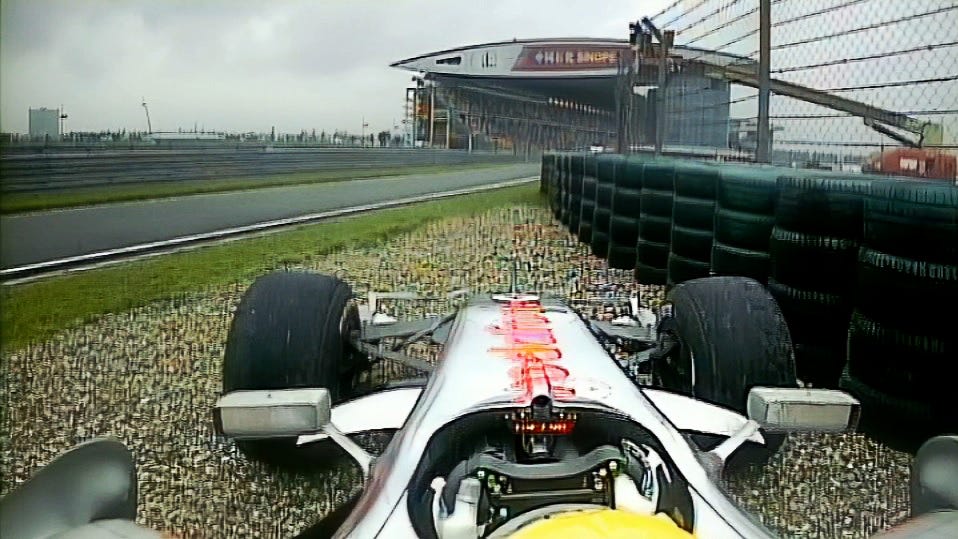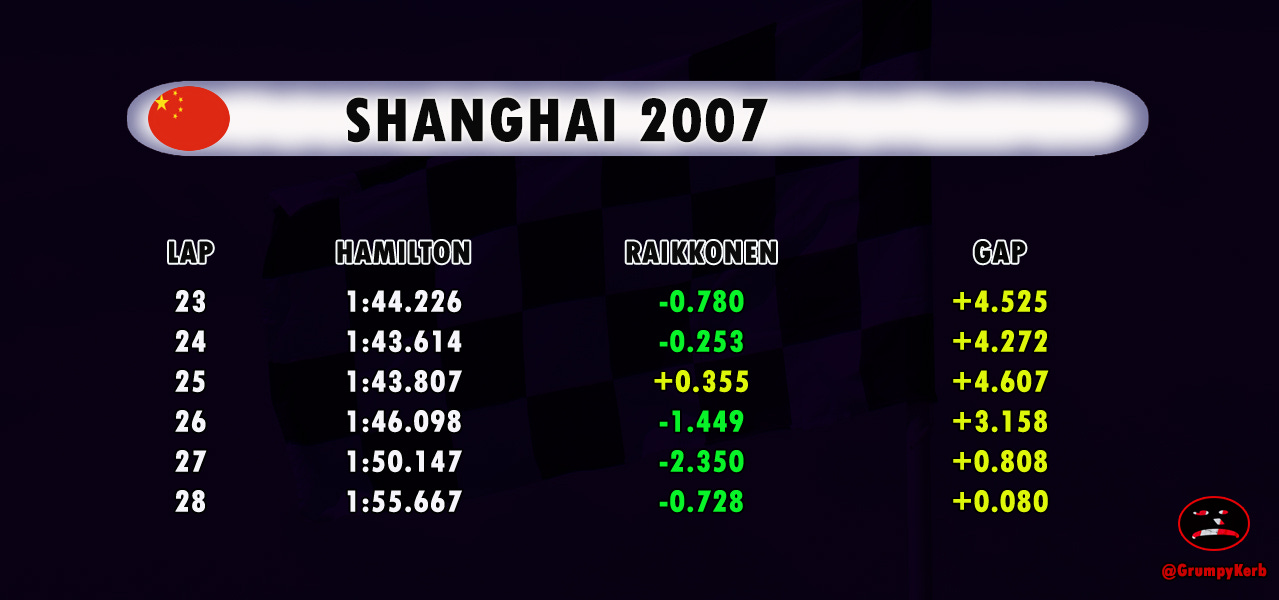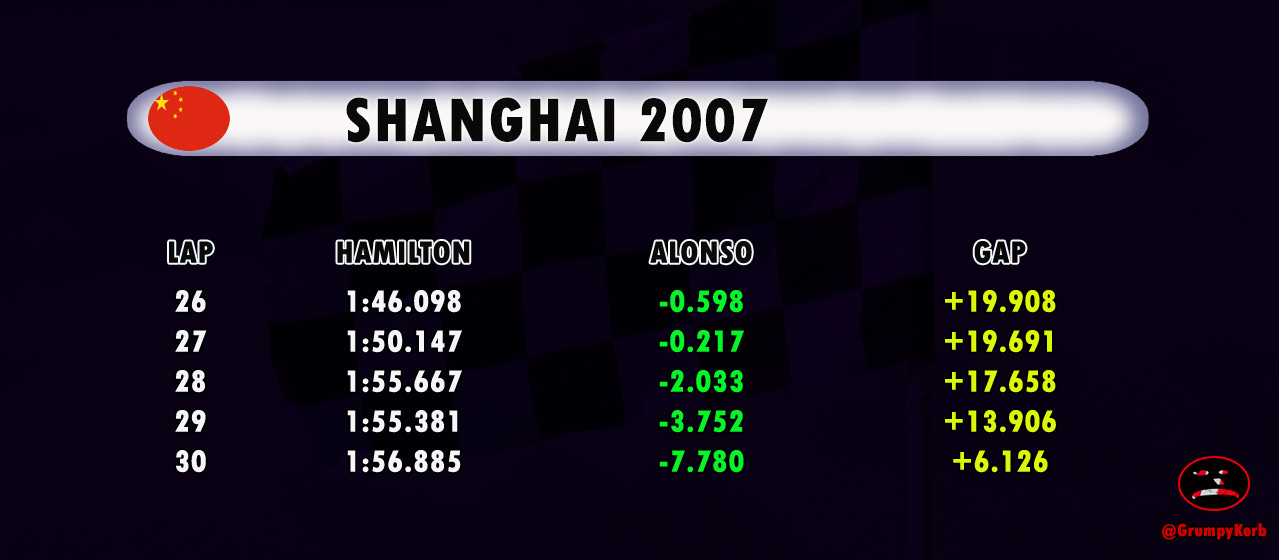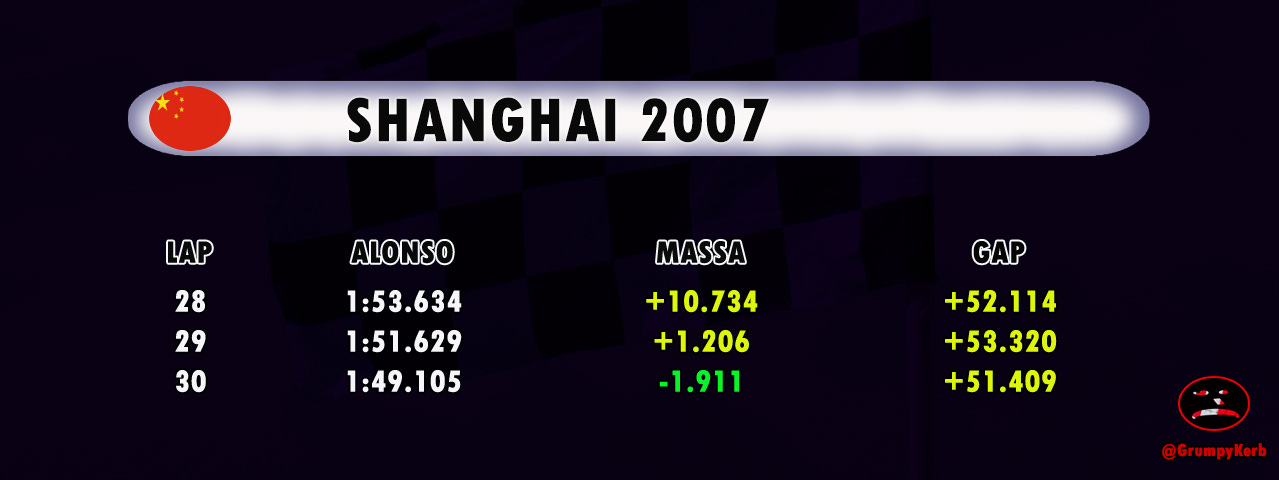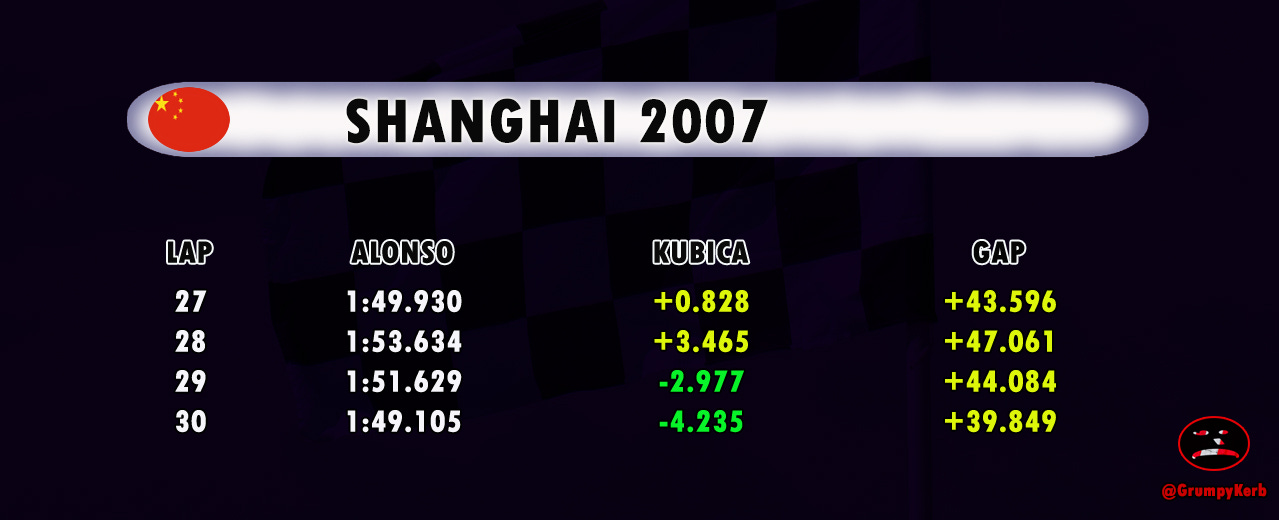Big Trouble in Eastern China
How McLaren's indecision and good intentions at the 2007 Chinese Grand Prix helped send Hamilton's would-be rookie championship into the gravel.
“We weren’t racing Kimi, we were basically racing Fernando. Kimi winning and Lewis coming second was adequate,” said Ron Dennis after the 2007 Chinese Grand Prix when journalists inquired why McLaren hadn’t pitted Lewis Hamilton, who was struggling on heavily worn intermediates.
The Fernando referred to by the McLaren Team Principal was, of course, Fernando Alonso, Hamilton’s teammate and championship rival, whom he led by 12 points before the race in Shanghai. He needed to finish ahead of the Spaniard to become the first rookie champion in the history of Formula 1.
Dennis’ words for sure won’t make the top 100 list of best PR lines, let alone the top 10. However, they provide insight into the team's decision-making during the crucial moments of the race—specifically, the indecision that led to a blunder.
From the Lead to the Gravel
The race couldn’t have started better for Hamilton, as he maintained the lead after the first corner, while Alonso stayed 4th behind the two Ferraris of Kimi Raikkonen and Felipe Massa. The track was damp, but it continued to dry as the cars dispersed more water with each lap.
Before his first pit stop on lap 15, Hamilton built a comfortable 8.612-second cushion over Raikkonen. The team refueled their driver but didn’t change the tires. Everyone in the top 4 opted to do the same, as it was the most optimal decision given the improving conditions.
Raikkonen boxed four laps later. The overcut and his rapid pace enabled the Ferrari driver to reduce the gap to 4.052 seconds by the end of the 20th lap. It rose to 5.305 seconds over the next two laps before rapidly deteriorating.
Hamilton hadn’t preserved his tires as well as chasing him Raikkonen. He was struggling more and more. To make matters worse, he defended his lead aggressively when the Iceman pressured him, which didn’t do any favor to his tires. In doing so, the McLaren driver only added fuel to the fire, even though he didn’t need to.
Raikkonen was 17 points behind Hamilton in the standings. With two races remaining, including the one in China, and the 10-8-6-5-4-3-2-1 scoring system, the Ferrari driver posed a threat only mathematically. The rookie could afford to finish behind him. He still would’ve won the title in Shanghai, provided he had finished ahead of Alonso.
Raikkonen overtook, or rather drove past, the struggling McLaren on lap 29 and disappeared. Hamilton stayed additional two laps on the track. He struggled as his rear right tire began to delaminate. Ultimately, he boxed on lap 31, only to lose control in the tight left-hand corner before the pit lane entry and beached the car in the gravel.
The chance of winning the title in China was literally buried. The door for Raikkonen to win it all in the following race at Interlagos opened wide.
Weather Sitting on the Fence
Alonso also preserved his tires better than his teammate. He was coming at Hamilton like a cheetah stalking a wounded antelope after overtaking Massa for P3 via his trademark switchback.
On the fateful 31st lap, maybe 2-3 seconds separated the McLaren duo on the short straight after Turn 14, just before Hamilton boxed. Had he stayed, Alonso would’ve driven past him just like Raikkonen did.
So why did McLaren wait so long? Because the weather couldn’t make its mind. It stayed on the cusp between inters and dry tires. To make matters worse, on lap 22, just before things began to go downhill for Hamilton, Race Control predicted that rain would arrive in 10 minutes. Consequently, the team found itself in a bit of a bind.
“We were getting weather information all the time. We didn't want to come in and get on the wrong tyre,” explained Martin Whitmarsh, McLaren’s Chief Operating Officer.
New inters are not a good choice when the track is on the verge of drying out. They need water. Otherwise they quickly overheat. They would’ve worked had more rain fallen. In that scenario, using dry tires would be akin to shooting yourself in the foot. On the other hand they would’ve been the best if the rain stopped.
And that’s what happened in the end. However McLaren hadn’t had the luxury of foresight. Speaking of luxury, that’s certainly something Raikkonen and Alonso enjoyed in the form of their ability to stay longer on the track, thanks to maintaining their worn inters in good shape.
Meanwhile, Hamilton was in deep trouble. He was so slow that he couldn’t stay ahead of Toyota’s Jarno Trulli, who unlapped himself at least twice. The Italian was on dry tires, but he was faster primarily due to the McLaren driver’s struggles rather than his pace.
The McLaren team had to make a decision. They chose to wait it out, hoping that the capricious weather would make its mind. Moreover, whatever call they made, their goal, as Dennis stated, was for Hamilton to finish ahead of Alonso, who was charging at the time.
What did they do? They sat on the fence, just like the weather. They only made the call when Hamilton’s rear right tire delaminated, and Alonso was about to snatch P2 from his teammate.
Live Timing: Massa
A weather radar is not the only tool that Formula 1 teams utilize in variable conditions. They also rely on timing screens.
Hamilton wasn’t the only driver who struggled on worn inters. Massa faced the same issue. On lap 26, after losing his position to Alonso in Turn 14, he promptly pitted for dry tires.
And it didn’t look promising for the Ferrari driver. His out lap was very poor: around 16 seconds slower compared to the lap following the Brazilian's first pit stop. He may have experienced an off-track adventure, or he simply struggled to heat up the tires effectively.
Furthermore, his lap times were nothing special compared to Alonso, who was the fastest driver among the top 3 at that time. It took Massa three laps to record a time faster than the McLaren driver.
That occurred on lap 30, just one lap before Hamilton dived into the pits. It was the appropriate moment to switch to dry tires. Evaluating the situation through the lens of Massa’s lap times, the “let’s wait” approach is at least somewhat defensible.
However, Massa wasn’t the only driver on dry tires during those crucial laps.
Live Timing: Kubica
Enter Robert Kubica. The BMW Sauber driver was employing a one-stop strategy. He switched to dry tires one lap ahead of Massa and didn’t struggle as much.
He had a poor lap 28, likely due to the troublesome weather that brought some rain, as nearly all of the top 5 clocked slower times. However, on the following lap, he was 2.977 seconds faster than Alonso. So two laps before McLaren called Hamilton to pit, it was evident that dry tires were the optimal choice for the conditions.
I am unsure what the weather radar indicated, but the timing screens were unequivocally clear.
McLaren chose to wait instead. They even delayed pitting Alonso for too long, and Ferrari did the same, to be fair. This hesitation allowed Kubica to undercut both Raikkonen and Alonso. The Pole briefly led the race, and who knows—perhaps he would’ve won if it weren't for the hydraulic failure.
Of course, Kubica wasn’t in contention for the championship, so he could afford to make a bold decision—a small gamble. McLaren had to play it safe, given the stakes, much like Ferrari did with Raikkonen. Since Massa was out of the championship fight, the team could take more risks with his strategy.
The Burden of the Stakes
Hamilton had worn out his tires and beached his car. These are valid criticisms. However it’s clear that McLaren left their driver hung out to dry and help him immensely to end up stranded in the gravel. Ironically, their desire for him to finish ahead of Alonso in order to secure the title in China partially led to this outcome.
Sometimes, when the stakes are very high, people become hesitant to make decisions that would be straightforward in normal, less stressful circumstances. I suppose that’s what happened at McLaren during the critical laps 28-31.




